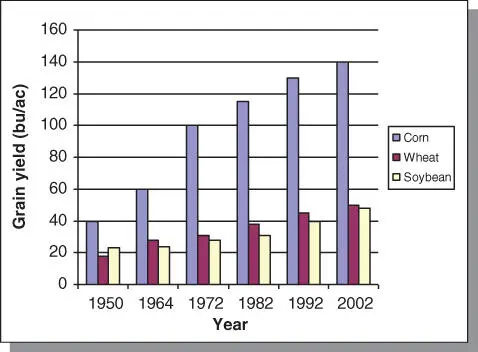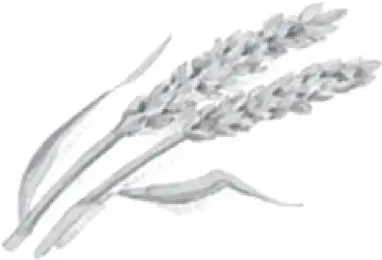1.8 Training of plant breeders
Training of plant breeders is a critical consideration in the strategies for addressing global food security. There is the need to train highly skilled professionals who will lead national agricultural research programs to address critical needs in developing local varieties for agricultural production. The traditional approach was offering scholarships to talented scholars from developing countries to pursue terminal degrees at overseas universities. Some of these scholars did not return to their home countries after training. More importantly, many of those who returned often worked on crops that were not native to their countries during their training. Significant efforts have been made to provide advanced training at the graduate level to scholars at their national universities or international institutes. In 2000, the African Center for Crop Improvement (ACCI) was created at the University of Kwazulu‐Natal, South Africa, in collaboration with Cornell University, for the purpose of training plant breeders for Africa. The initiative was so successful that a parallel program, West Africa Center for Crop Improvement (WACCI) was established at the University of Ghana, Legon, in 2009. The initiative was supported by the Bill and Melinda Gates Foundation, the Rockefeller Foundation, and later by the Alliance for a Green Revolution in Africa (AGRA). These scholars are able to work with African crops during their training, thereby making the transition to professional practice as plant breeders after training seamless (see Box 1.1) ( Figure 1.1).

Figure 1.1The yield of major world food crops is steadily rising. A significant portion of this rise is attributable to the use of improved crop cultivars by crop producers.
Source: Drawn with data from the USDA
.
1.9 The plant breeding industry
Commercial plant breeding is undertaken in both the private and public sectors. Breeding in the private sector is primarily for profit. A sample of the major plant breeding companies in the world is presented in Table 1.3. Many of these companies operate under the umbrella of giant multinational corporations such as Monsanto, Pioneer/DuPont, Novartis/Syngenta, and Advanta Seed Group, through mergers and acquisitions. Products from private seed companies are proprietary. In the US, an estimated 65–75% of all plant breeders are employed in the private sector. More importantly, crop species that are self‐pollinated (e.g. wheat) and hence allow farmers to save seed to plant the next season's crop, are of less interest to commercial seed breeders in the private sector. An estimated 80% of wheat breeders in the US are in the public sector while only about 7% of corn (cross‐pollinated, readily amenable to hybrid production) breeders are in the public sector. Most germplasm enhancement (pre‐breeding, introduction of exotic genes into cultivated germplasm) efforts occur mainly in the public sector. Funds for public breeding in wheat come from contributions from the wheat growers' association.
Table 1.3Selected seed companies in various parts of the world.
| Holland |
| Bakker Brothers |
| Bejo Zaden BV |
| De Ruiter Seeds |
| Pinnar Seed BV |
| Van Dijke Zaden |
| Enza Zaden BV |
| Nikerson‐Zwaan BV |
| Germany |
| Hild Samen GmbH |
| Nikerson‐Zwaan GmbH |
| United Kingdom |
| CN Seed Ltd. |
| Tozer Seeds |
| Nikerson‐Zwaan GmbH |
| France |
| Clause |
| Panam Semences |
| Vilmorin |
| Technisem |
| Gautier Semences |
| South Africa |
| Capstone Seeds |
| Gellman Seeds Pty. Ltd. |
| JW Seeds |
| Pinnar Seed |
| Sensako |
| Kenya |
| Pinnar Seed |
| United States of America |
| Seminis |
| Syntenta Seeds |
| Monsanto |
| DeKalb |
| Danson Seeds |
| Campbell's Seed |
| Burpee |
| Pioneer |
The private sector dominates corn breeding throughout the industrial world. However, the roles of the public and private sectors differ markedly in Western Europe, different regions of the USA, Canada, and Australia.
1.9.1 Private sector plant breeding
Four factors are deemed by experts to be critical in determining the trends in investment in plant breeding by the private sector.
Cost of research innovationModern plant breeding technologies are generally expensive to acquire and use. Consequently, the cost of research and development of new cultivars by these technologies are exorbitant. However, some of these innovations result in increased product quality and yield, and sometimes facilitate the production of the crop by the producer. Also, some innovations eventually reduce the duration of the cumulative research process.
Market structurePrivate companies are more likely to invest in plant breeding where the potential size of the seed market is large and profitable. Further, the attraction to enter into plant breeding will be greater if there are fixed costs in marketing the new cultivars to be developed.
Market organization of the seed industryConventional wisdom suggests that the more concentrated a seed market, the greater the potential profitability of a seed production enterprise. However, contemporary thought on industrial organization suggests that the ease of entry into an existing market would depend on the contestability of the specific market, and subsequently decide the profitability to the company. Plant breeding is increasingly becoming a technology‐driven industry. Through research and development, a breakthrough may grant a market monopoly to an inventor of a technology or product, until another breakthrough occurs that grants a new monopoly in a related market. For example, Monsanto, the developer of Roundup Ready® technology, is also the developer of the Roundup® herbicide that is required for the technology to work.
Ability to appropriate the returns to research and distribution of benefitsThe degree to which a seed company can appropriate returns to its plant breeding inventions is a key factor in the decision to enter the market. Traditionally, cross‐pollinated species (e.g. corn) that are amenable to hybrid breeding and high profitability have been most attractive to private investors. Public sector breeding develops most of the new cultivars in self‐pollinated species (e.g. wheat, soybean). However, the private sector interest in self‐pollinated species is growing. This shift is occurring for a variety of reasons. Certain crops are associated in certain cropping systems. For example, corn–soybean rotations are widely practiced. Consequently, producers who purchase improved corn are likely to purchase improved soybean seed. In the case of cotton, the shift is for a more practical reason. Processing cotton to obtain seed entails ginning and delinting, which are more readily done by seed companies than farmers.
 Industry highlights Box 1.1 Training game changers in plant breeding at the West Africa Centre for Crop Improvement (WACCI) in Africa for Africa
Industry highlights Box 1.1 Training game changers in plant breeding at the West Africa Centre for Crop Improvement (WACCI) in Africa for Africa
Читать дальше


 Industry highlights Box 1.1 Training game changers in plant breeding at the West Africa Centre for Crop Improvement (WACCI) in Africa for Africa
Industry highlights Box 1.1 Training game changers in plant breeding at the West Africa Centre for Crop Improvement (WACCI) in Africa for Africa










